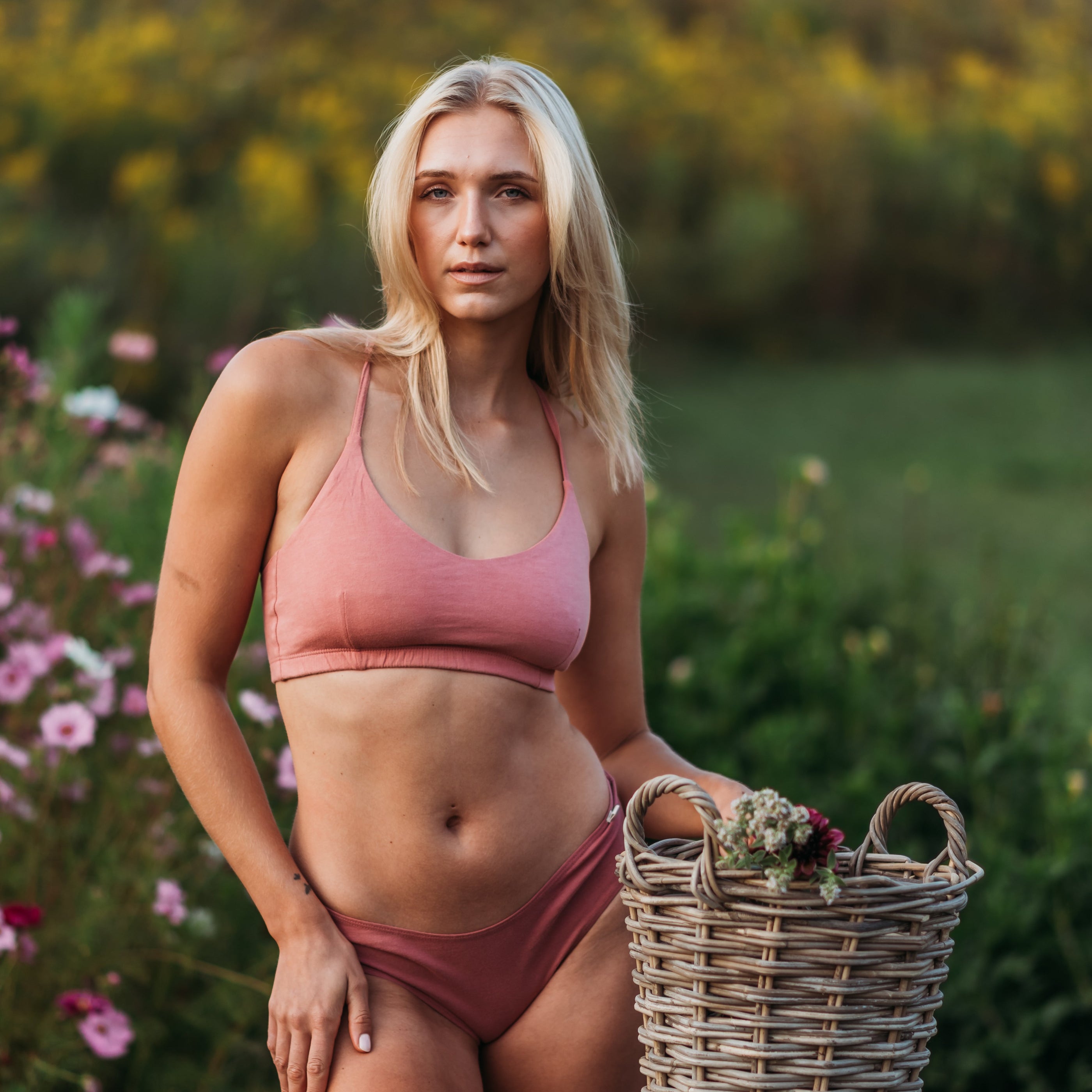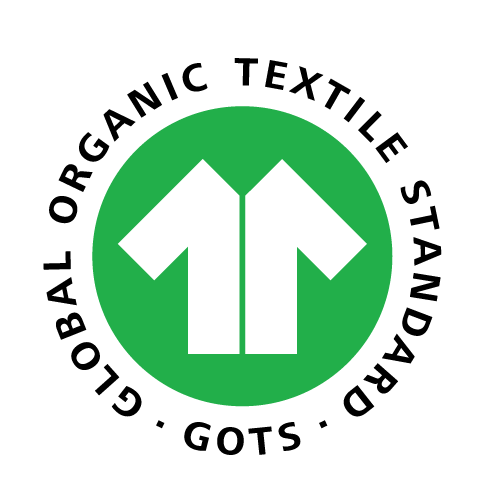
100% Organic Cotton Bras? What It Really Means and Hidden Fibers to Know
Buying a bra labeled “100% organic cotton” sounds like the perfect choice for comfort and sustainability. But does it literally mean everything in that bra is pure organic cotton? In reality, bras are complex garments with many components, and even the most “eco-friendly” ones often include hidden fibers you might not notice at first glance. Here, we’ll break down what the 100% organic cotton label signifies, why bras are rarely made entirely of cotton, and what other materials (like elastane, polyester, bamboo, or modal) could be lurking in your lingerie. We’ll also explore the difference between “organic” and “clean” bras, and give you solid, research-backed reasons as to why organic cotton bras are worth the hype for your health and the planet.
What Does "Organic Cotton" Mean For a Bra?

“Organic cotton” refers to cotton grown without synthetic pesticides or fertilizers, often certified by strict standards (like the Global Organic Textile Standard, GOTS). This stands in contrast to regular cotton, which is typically grown using synthetic chemicals, including pesticides and fertilizers, that can harm the environment and leave residues on the fabric. Organic cotton farming prioritizes sustainability, soil health, and biodiversity, ensuring that no harmful chemicals are used throughout the growing process. On the other hand, conventional cotton farming is resource-intensive and contributes to soil degradation and water contamination due to the chemicals used.
If a bra is marketed as organic cotton, the main fabric comes from cotton plants cultivated in an environmentally friendly way. However, 100% on a label can be tricky – it typically means all textile parts of the garment are cotton (excluding non-fabric pieces like buckles). In a simple T-shirt, that might literally be 100% cotton. But a bra is not so simple; it can have 20, 30, or more separate pieces sewn together (cups, bands, straps, linings, elastic, thread, etc.). For a bra to truly be 100% cotton, every fabric component would need to be cotton – a rare scenario in practice.
Importantly, 100% cotton doesn’t automatically guarantee a toxin-free finished product. A cotton crop might be grown organically but then processed with harsh chemicals for dyeing or finishing. Without additional certifications, an “organic cotton” bra could still contain harmful residues. That’s why savvy shoppers look for certifications like GOTS (which covers not just organic farming but also bans toxic processing chemicals). A GOTS-certified organic cotton bra ensures the entire production meets strict environmental and social criteria – from farm to fabric – giving you confidence that the cotton is truly organic and processed in a clean, non-toxic way. Another label to watch for is OEKO-TEX® Standard 100, which confirms that every component (down to threads and dyes) has been tested for harmful substances. In short, “100% organic cotton” tells you about the main material, but certifications tell you the whole story about how that bra was made.
Why Are Most Bras Not Made of 100% Cotton?
You might wonder why it’s hard to find a bra that is made entirely of cotton. The reality is that bra design requires a blend of materials to give you the fit and support you need. Here are a few reasons nearly all bras (even “cotton” bras) use some non-cotton components:
Most bra makers usually mix cotton with a bit of something else to give the final product the needed stretch, strength, and longevity. Even when a bra advertises a high cotton content (e.g. “95% organic cotton”), the remaining percent is typically spandex or another fiber to make sure the bra retains its shape and support. This doesn’t mean the bra is low quality – it means the designer chose functionality and fit, using just enough synthetic fiber to improve performance while keeping cotton next to your skin.
At Q for Quinn is one of the few brands offering pure 100% organic cotton bras and bralettes. They are designed to provide comfort, support, and sustainability. Our bras feature organic cotton as the main material, with careful attention to design and performance. While they include small amounts of elastic for the perfect fit and stretch, we ensure that every piece of the bra is made with skin-friendly, eco-conscious materials, giving you a product that is both high-quality and comfortable.
5 Reasons Organic Cotton Bras Are More Than Just Hype

When it comes to bra materials, organic cotton stands out for its softness, breathability, and minimal environmental impact. While there are other fabrics used in bra manufacturing, each with its own benefits, no material quite compares to the natural, breathable feel of organic cotton. Bra designers often blend cotton with synthetic fibers like spandex or nylon to provide additional stretch, durability, and shape retention, but pure organic cotton remains one of the most comfortable and non-toxic materials for direct contact with skin.
- Safer for Sensitive Skin (Hypoallergenic & Irritation-Free). Organic cotton is renowned for being gentle on the skin – you practically never hear of cotton causing itchiness or allergic reactions. An organic cotton bra contains pure, natural fibers without residues of pesticides or harsh finishing agents, making it ideal for women with sensitive skin, eczema, or textile allergies. If you’ve ever gotten a rash from a bra, it could be from synthetic materials or latex or chemical finishes. Switching to an organic cotton bra can be a relief, as users report far less skin irritation with non-toxic and chemical-free bras. Simply put, organic cotton bras are hypoallergenic – they drastically cut down the likelihood that your bra is the cause of any redness, itching, or chafing on your delicate areas. For the ultra-sensitive skin, you can even find undyed underwear, unbleached organic cotton bras to eliminate dyes as a potential irritant — an approach recommended for those with severe skin conditions.
- Breathable and Sweat-Friendly. One of cotton’s best attributes is its breathability. The fiber structure of cotton allows air to circulate, which helps dissipate heat and keep you cool. This means an organic cotton bra will not stifle your skin the way a polyester or nylon bra might. Especially in warmer weather or if you’re prone to perspiring, a cotton bra can be a game-changer. As a result, sweat is managed better, and you’re less likely to experience that sticky, clammy feeling under the bust. Indeed, organic cotton bras are less likely to become breeding grounds for yeast or bacteria compared to sweaty sports bras made of poly blends. Many gynecologists recommend cotton undies for similar reasons – breathability is key for female health. The same logic applies to bras: choosing a bra made largely of cotton (especially in the cup and band that sit against skin) can help keep the area dry and comfortable. If you’ve ever suffered “bra sweat” or an underboob rash, making the switch to breathable organic cotton is a wise move (and yes, cotton underwear is breathable — see our deep dive on cotton’s breathability in underwear for more on how this works).
- Soft Comfort (No More Scratchy Bras!). There’s a reason we love our old cotton T-shirts – cotton is soft. Organic cotton, in particular, often has a wonderful, soft handfeel because the fibers aren’t damaged by harsh chemicals in processing. Many wearers describe organic cotton bras (especially those made with high-quality cotton like Pima or long-staple varieties) as supremely comfortable, almost like a second skin. In fact, cotton is widely regarded as one of the most comfortable fabrics in the world to wear. An organic cotton bra will tend to mold to your body gently with wear, becoming even softer over time, but it’s also breathable so it doesn’t create that sticky feeling. Additionally, while cotton doesn’t have a lot of innate stretch, many organic cotton bras are designed as wire-free, non-restrictive styles (like soft cup bras or bralettes) that prioritize comfort over ultra-structured shape. Women often find that a simple organic cotton bralette is far more comfortable for everyday wear than a sculpted push-up bra made of foam and polyester. So, if you compare bra vs bralette, then bralettes win for comfort and a healthier option. At Q for Quinn, we offer only healthy GOTS-certified organic cotton bralettes and cotton sports bras, which are very rare to find on the market. Alongside that, we also offer underwear for sensitive skin, undyed underwear, and plant dyed underwear, which are the healthiest options for your skin and environment.
- Eco-Friendly and Sustainable Choice. Choosing organic cotton isn’t just good for you – it’s good for the planet. Traditional cotton agriculture is heavy on pesticides and fertilizers, which can harm ecosystems, pollute water, and impact farm workers’ health. According to sustainability research, organic farming methods can reduce water pollution by up to 98% compared to conventional cotton farming, since there are no synthetic pesticides and far less fertilizer runoff. Furthermore, organic cotton farmers often use water more efficiently (through rain-fed crops or better soil retention). An organic cotton bra also means the manufacturing process likely avoided toxic chemicals, making it better for the workers and for the environment when effluents are treated. The fabric biodegrades at end-of-life (unlike synthetics, which can shed microplastics and persist for decades), and it doesn’t introduce persistent chemicals into the environment. Organic cotton generally has a lighter environmental footprint than conventional cotton, and cutting out the worst chemicals is an undeniable win.
- High Quality and Durability. Organic cotton bras can be an investment up front (they sometimes cost a bit more than fast-fashion bras), but they often last longer, giving you more value over time. One reason is that many organic cotton bras are made with different cotton fibers – for instance, brands may use Pima cotton, which is an extra-long staple cotton known for its strength, softness, and longevity. Because organic cotton pieces tend to be made by companies focused on quality, the stitching and construction might be better, further extending the bra’s life. On the flip side, cheap bras with synthetic lace might stretch out or wires pop through in a few months. A well-made cotton bra, especially without an underwire, can be a trusty companion for a long time if cared for. An organic cotton bra fits that philosophy: it’s built to be worn on repeat, and feel even better after each wash (cotton often softens with washing, unlike some synthetics that can break down or start to irritate with time). The result is a bra that’s truly worth the cost and then some.
Why Bamboo and Modal Can’t Be Organic – And Why It Can Be Confusing
A discussion about organic fabrics wouldn’t be complete without addressing two popular “green” materials you might see in the lingerie aisle: bamboo and modal. Sometimes, brands market bamboo bras or modal underwear as if they’re similar to organic cotton (natural, sustainable, etc.). While these fibers can have sustainability merits, it’s important to clarify a key point: neither bamboo viscose nor modal is an “organic” fiber in the true sense – and they often involve heavy chemical processing.
Bamboo
The idea of a bamboo bra sounds great – bamboo grows quickly without much need for pesticides, so many assume bamboo fabric is eco-friendly and natural. However, the soft bamboo fabric used in clothing is almost always viscose rayon made from bamboo cellulose. The bamboo stalks don’t magically turn into silky fiber; they undergo a harsh chemical process. In fact, the Global Organic Textile Standard explicitly states that bamboo fiber used in industrial textile production is not considered natural or organic, because the bamboo is “melted and regenerated” through a chemical viscose process. Even if the bamboo plant was grown organically, by the time it’s processed into fiber, it’s no longer organic material – it’s a man-made regenerated fiber. The U.S. Federal Trade Commission (FTC) has cracked down on companies for misleading labeling of bamboo textiles. The FTC emphasizes that rayon from bamboo has no trace of the original plant left; what you get is rayon, which uses toxic chemicals (like sodium hydroxide and carbon disulfide) to dissolve the bamboo pulp and reform it into fibers. They even fined companies for calling it “bamboo” fabric, insisting it be labeled as rayon. The takeaway for bras: if you see a “bamboo bra,” read the fabric content. It will likely say something like “Bamboo viscose (rayon) and spandex.” Bamboo viscose can be very soft and breathable, yes – some women love bamboo fabric for its drape and softness. But understand it’s not an organic fiber and may have been produced with chemicals that raise environmental concerns.
For more insights into the differences between bamboo fabric and truly organic materials, check out our article on Bamboo vs. Organic Clothing, where we break down the impact of bamboo processing and its environmental effects compared to organic cotton fabric.
Modal
Modal fabric is often touted as a sustainable fabric because it’s made from renewable wood pulp (often beech trees) and can be produced in eco-friendlier ways than old-school rayon. However, modal is a type of rayon – a semi-synthetic fiber. It’s processed with chemicals (the modern modal process uses solvents in a somewhat more efficient way, especially the TENCEL™ Modal brand). The key point is that modal is not a fully organic fiber. In fact, there’s no such thing as “certified organic modal”. The term “organic” in textiles is usually reserved for fibers that are grown naturally (like cotton, wool, linen) under organic agriculture. Modal starts with natural inputs (wood cellulose) but by the time it becomes a fiber, it has been chemically transformed. Calling modal fabric “organic” is misleading. Some brands might phrase things like “organic cotton-modal blend,” meaning the cotton is organic but modal isn’t.
As consumers, if you see modal, just remember it’s a man-made fiber – it can be very eco-friendly in certain ways (e.g., Lenzing’s Modal uses sustainably managed forests and recycles most chemicals), and modal fabric is loved for its silky smooth feel and cool touch. Actually, modal often pairs nicely with organic cotton in blends to add softness and stretch (without resorting to polyester). We’re not knocking modal’s comfort – just clarifying that it doesn’t meet the definition of “organic fiber.” In a modal vs. cotton showdown, modal might win on slick softness and maybe moisture-wicking, but cotton wins on being 100% natural and generally more breathable against skin. If you’re looking for the purest natural option, stick to organic cotton.
To learn more about how modal compares to organic cotton when it comes to fabric choices, check out our article on Modal vs. Cotton Underwear, where we dive deeper into the benefits and differences of these fabrics.
In summary, be wary of greenwashing when it comes to “alternative” materials and learn how to tell if fabric is 100% organic cotton. Bamboo and modal can be part of sustainable fashion discussions, but they are not organic fibers. If you want an organic bra, your main choices are organic cotton, or sometimes blends like organic cotton with a bit of organic linen or wool (rare in bras). However, the vast majority of “eco bras” will feature organic cotton as the main ingredient. Now you know that “bamboo” bras = rayon, and modal bras = semi-synthetic, so you can make informed choices.
We encourage you to explore these fabric comparisons (bamboo vs. cotton, modal vs. cotton) to find what works best for you. Also, consider women’s health factors like breathability and moisture-wicking when choosing underwear. Below are articles on how fabric choices affect comfort and well-being.









